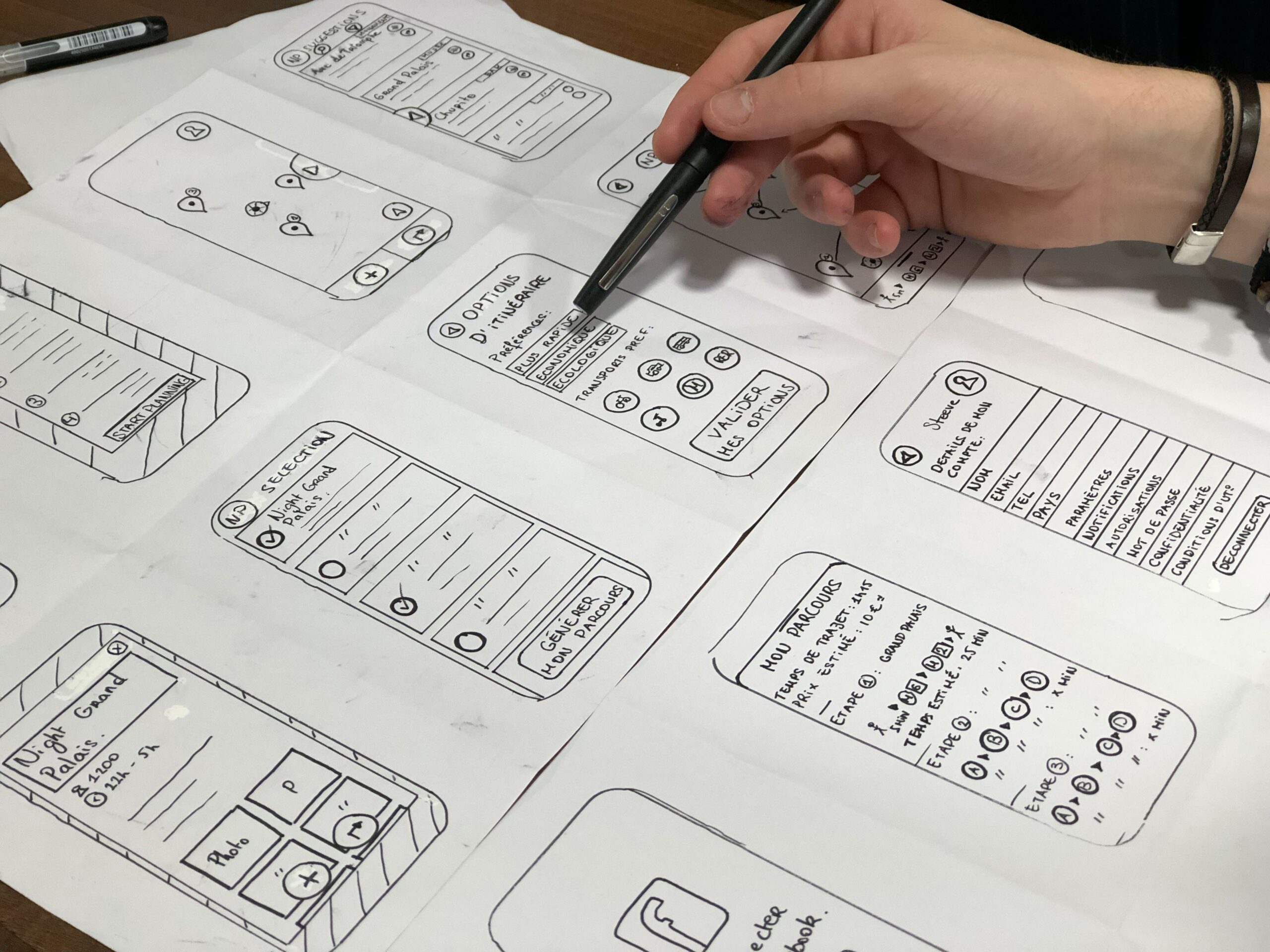A Guide to Mobile-First UX Design for E-commerce Businesses is a comprehensive resource that aims to help e-commerce businesses optimize their user experience (UX) design specifically for mobile devices. With the increasing dominance of mobile usage in online shopping, it has become crucial for businesses to prioritize mobile-first design strategies to enhance customer satisfaction and drive conversions. This guide provides valuable insights, best practices, and practical tips to create intuitive, responsive, and visually appealing mobile experiences that cater to the unique needs and behaviors of mobile users. By following the principles outlined in this guide, e-commerce businesses can effectively engage their mobile audience, improve usability, and ultimately boost their online sales.
The Importance of Mobile-First UX Design in E-commerce Businesses
In today’s digital age, mobile devices have become an integral part of our lives. People rely on their smartphones and tablets for various tasks, including shopping. As a result, e-commerce businesses must prioritize mobile-first user experience (UX) design to stay competitive in the market. This article will explore the importance of mobile-first UX design for e-commerce businesses and provide a guide to implementing it effectively.
First and foremost, it is crucial to understand why mobile-first UX design is essential for e-commerce businesses. With the increasing number of mobile users, having a website that is optimized for mobile devices is no longer a luxury but a necessity. Studies have shown that a majority of online shoppers use their smartphones to browse and make purchases. If your website is not mobile-friendly, you risk losing potential customers to competitors who have invested in mobile-first design.
One of the key benefits of mobile-first UX design is improved user engagement. When users have a seamless and enjoyable experience on your mobile website, they are more likely to stay longer, explore your products, and make a purchase. On the other hand, if your website is slow, difficult to navigate, or not visually appealing on mobile devices, users will quickly abandon it and move on to a competitor’s site. By prioritizing mobile-first design, you can create a positive user experience that keeps customers engaged and encourages them to return.
Another advantage of mobile-first UX design is increased conversion rates. When your website is optimized for mobile devices, it becomes easier for users to complete their purchases. Mobile-friendly features such as simplified checkout processes, easy-to-use navigation menus, and clear call-to-action buttons can significantly improve conversion rates. By removing any barriers that may hinder the purchasing process, you can increase the likelihood of users completing their transactions and becoming loyal customers.
Furthermore, mobile-first UX design can enhance your brand’s reputation and credibility. When users have a positive experience on your mobile website, they are more likely to perceive your brand as trustworthy and reliable. On the other hand, a poorly designed mobile website can create a negative impression and damage your brand’s reputation. By investing in mobile-first design, you can ensure that your brand is associated with a positive user experience, which can lead to increased customer loyalty and word-of-mouth referrals.
Now that we understand the importance of mobile-first UX design, let’s explore how to implement it effectively. Firstly, it is crucial to prioritize responsive design. Responsive design ensures that your website adapts to different screen sizes and resolutions, providing a consistent and user-friendly experience across all devices. This includes optimizing images and videos, using legible fonts, and ensuring that buttons and links are easily clickable on mobile screens.
Secondly, consider the loading speed of your mobile website. Mobile users have limited patience, and if your website takes too long to load, they will quickly abandon it. Optimize your website’s performance by minimizing file sizes, leveraging browser caching, and using content delivery networks (CDNs) to deliver your website’s assets quickly.
Lastly, pay attention to the user interface (UI) and user experience (UX) design of your mobile website. Ensure that the navigation is intuitive and easy to use, with clear menus and search functionality. Use visual cues and feedback to guide users through the purchasing process, and make sure that important information, such as product details and pricing, is easily accessible.
Best Practices for Implementing Mobile-First UX Design in E-commerce
In today’s digital age, mobile devices have become an integral part of our lives. With the increasing popularity of smartphones and tablets, it is no surprise that mobile commerce, or m-commerce, is on the rise. As a result, e-commerce businesses must adapt to this shift in consumer behavior by implementing mobile-first user experience (UX) design.
Mobile-first UX design is a design approach that prioritizes the mobile user experience over the desktop experience. It involves creating a seamless and intuitive experience for users accessing a website or app on their mobile devices. This is crucial for e-commerce businesses as it directly impacts customer satisfaction, engagement, and ultimately, conversions.
To successfully implement mobile-first UX design in e-commerce, there are several best practices that businesses should follow. Firstly, it is essential to prioritize simplicity and minimalism in the design. Mobile screens are smaller than desktop screens, so cluttered and complex designs can be overwhelming for users. By keeping the design clean and simple, businesses can ensure that users can easily navigate and find what they are looking for.
Another best practice is to optimize the website or app for touch interactions. Unlike desktops, mobile devices rely heavily on touch gestures such as swiping, tapping, and pinching. Therefore, it is crucial to design buttons, menus, and other interactive elements with touch in mind. This includes making buttons large enough to be easily tapped, ensuring there is enough spacing between elements to prevent accidental taps, and providing visual feedback when an action is performed.
Furthermore, businesses should prioritize speed and performance in their mobile-first UX design. Mobile users have little patience for slow-loading websites or apps. To optimize speed, businesses should minimize the use of large images and videos, compress files, and leverage caching techniques. Additionally, it is important to conduct regular performance testing to identify and address any bottlenecks that may affect the user experience.
Another key aspect of mobile-first UX design is responsive design. Responsive design ensures that the website or app adapts to different screen sizes and orientations. This is crucial as mobile devices come in various sizes and resolutions. By implementing responsive design, businesses can provide a consistent and optimized experience across different devices, enhancing user satisfaction and engagement.
In addition to these best practices, businesses should also consider the importance of mobile-friendly content. Mobile users have different needs and behaviors compared to desktop users. Therefore, it is important to tailor the content to suit the mobile context. This includes using concise and scannable text, optimizing images for mobile viewing, and prioritizing important information above the fold.
Lastly, businesses should continuously gather user feedback and conduct usability testing to improve their mobile-first UX design. User feedback provides valuable insights into the user experience and can help identify areas for improvement. Usability testing involves observing users as they interact with the website or app and identifying any usability issues or pain points. By incorporating user feedback and conducting regular usability testing, businesses can refine their mobile-first UX design and ensure it meets the needs and expectations of their target audience.
How Mobile-First UX Design Can Improve Conversion Rates in E-commerce
In today’s digital age, mobile devices have become an integral part of our lives. People are increasingly using their smartphones and tablets to browse the internet, shop online, and make purchases. As a result, e-commerce businesses need to adapt to this shift in consumer behavior by prioritizing mobile-first user experience (UX) design.
Mobile-first UX design refers to the practice of designing websites and applications with the mobile user in mind first, before considering the desktop experience. This approach recognizes the fact that more and more people are accessing the internet through their mobile devices, and aims to provide them with a seamless and enjoyable browsing and shopping experience.
One of the key benefits of mobile-first UX design for e-commerce businesses is its potential to improve conversion rates. Conversion rate is a crucial metric for any online business, as it measures the percentage of visitors who take a desired action, such as making a purchase or signing up for a newsletter. By optimizing the mobile user experience, businesses can increase the likelihood of visitors converting into customers.
One way mobile-first UX design can improve conversion rates is by reducing friction in the purchasing process. Mobile users often have limited screen space and slower internet connections compared to desktop users. Therefore, it is essential to streamline the checkout process and eliminate any unnecessary steps or distractions. By simplifying the user interface and making it easy for customers to complete their purchase, businesses can reduce cart abandonment rates and increase conversions.
Another aspect of mobile-first UX design that can improve conversion rates is responsive design. Responsive design ensures that websites and applications adapt to different screen sizes and resolutions, providing a consistent and optimized experience across devices. This is particularly important for e-commerce businesses, as customers may start their shopping journey on one device and continue it on another. By offering a seamless transition between devices, businesses can reduce friction and encourage customers to complete their purchase.
Furthermore, mobile-first UX design can enhance the overall user experience, making it more enjoyable and engaging for customers. This can be achieved through various techniques, such as intuitive navigation, clear and concise product descriptions, and high-quality images. By providing a visually appealing and user-friendly interface, businesses can create a positive impression and build trust with their customers, ultimately leading to higher conversion rates.
In addition to improving conversion rates, mobile-first UX design can also have a positive impact on search engine optimization (SEO). In recent years, search engines like Google have started prioritizing mobile-friendly websites in their search results. This means that businesses with a mobile-first approach are more likely to rank higher in search engine results pages, increasing their visibility and attracting more organic traffic. By combining mobile-first UX design with effective SEO strategies, e-commerce businesses can further boost their conversion rates and drive more sales.
Key Elements of Mobile-First UX Design for E-commerce Websites
In today’s digital age, mobile devices have become an integral part of our lives. With the increasing popularity of smartphones and tablets, it is no surprise that mobile commerce, or m-commerce, is on the rise. As a result, e-commerce businesses must adapt to this shift in consumer behavior by prioritizing mobile-first user experience (UX) design.
Mobile-first UX design is a design approach that focuses on creating a seamless and intuitive user experience specifically for mobile devices. It involves designing and optimizing a website or application for mobile devices first, and then scaling up to larger screens such as desktops or laptops. This approach is crucial for e-commerce businesses as it ensures that their websites are user-friendly and accessible to the growing number of mobile users.
There are several key elements that e-commerce businesses should consider when implementing mobile-first UX design. Firstly, it is important to prioritize simplicity and minimalism in the design. Mobile screens are smaller than desktop screens, so it is essential to declutter the interface and prioritize the most important elements. This can be achieved by using clean and concise typography, reducing the number of images and graphics, and simplifying navigation menus.
Secondly, responsive design is a fundamental aspect of mobile-first UX design. Responsive design ensures that the website or application adapts to different screen sizes and resolutions, providing a consistent and optimized experience across all devices. This means that users can easily navigate and interact with the website or application, regardless of whether they are using a smartphone, tablet, or desktop computer.
Another key element of mobile-first UX design is fast loading times. Mobile users have shorter attention spans and are more likely to abandon a website or application if it takes too long to load. Therefore, it is crucial to optimize the website or application for speed by minimizing file sizes, compressing images, and leveraging caching techniques. Additionally, it is important to prioritize content that is relevant and valuable to mobile users, as they are often looking for quick and concise information.
Furthermore, mobile-first UX design should prioritize touch-friendly interactions. Unlike desktop users who rely on a mouse or trackpad, mobile users interact with the screen using their fingers. This means that buttons, links, and other interactive elements should be large enough and spaced out appropriately to accommodate touch gestures. Additionally, it is important to consider the placement and size of form fields and input elements to ensure ease of use on mobile devices.
Lastly, mobile-first UX design should take into account the context in which users are accessing the website or application. Mobile users are often on the go and have different needs and expectations compared to desktop users. Therefore, it is important to consider factors such as location, time of day, and user intent when designing the user experience. For example, a mobile e-commerce website could offer personalized recommendations based on the user’s location or provide a simplified checkout process for users who are in a hurry.
Case Studies: Successful Mobile-First UX Design in E-commerce Businesses
In today’s digital age, mobile devices have become an integral part of our lives. With the increasing popularity of smartphones and tablets, it is no surprise that mobile commerce, or m-commerce, has been on the rise. As a result, e-commerce businesses are recognizing the importance of optimizing their websites for mobile users. This shift towards mobile-first design has proven to be successful for many businesses, as evidenced by several case studies.
One such case study is the success story of Amazon. As one of the largest e-commerce platforms in the world, Amazon understands the significance of providing a seamless mobile experience to its customers. By adopting a mobile-first approach, Amazon has been able to enhance its user experience and increase its mobile sales. The company’s mobile app is designed to be user-friendly, with a simple and intuitive interface that allows customers to easily navigate through the site and make purchases. Additionally, Amazon has implemented features such as one-click ordering and personalized recommendations, which further enhance the mobile shopping experience.
Another notable case study is that of Airbnb. As a platform that connects travelers with hosts, Airbnb recognized the need to prioritize mobile users. By focusing on mobile-first design, Airbnb was able to create a user-friendly app that allows travelers to easily search for accommodations, book their stay, and communicate with hosts. The app’s interface is clean and intuitive, with clear navigation and visually appealing images. Airbnb also implemented features such as instant booking and secure payment options, which have contributed to the app’s success and increased user engagement.
A third case study that highlights the benefits of mobile-first design is that of Walmart. As a retail giant, Walmart understands the importance of catering to mobile users. The company’s mobile app is designed to provide a seamless shopping experience, with features such as easy product search, personalized recommendations, and a streamlined checkout process. Walmart also offers features such as in-store pickup and mobile payment options, which have contributed to increased customer satisfaction and loyalty.
These case studies demonstrate the positive impact of mobile-first UX design on e-commerce businesses. By prioritizing mobile users and creating user-friendly interfaces, these companies have been able to enhance the overall user experience and increase their mobile sales. The success of these businesses serves as a testament to the importance of mobile-first design in today’s digital landscape.
In conclusion, mobile-first UX design is crucial for e-commerce businesses looking to thrive in the mobile era. By adopting a mobile-first approach and creating user-friendly interfaces, businesses can enhance the overall user experience and increase their mobile sales. The case studies of Amazon, Airbnb, and Walmart highlight the benefits of mobile-first design and serve as inspiration for other businesses looking to optimize their websites for mobile users. As mobile devices continue to dominate the digital landscape, it is essential for e-commerce businesses to prioritize mobile-first UX design in order to stay competitive and meet the evolving needs of their customers.



